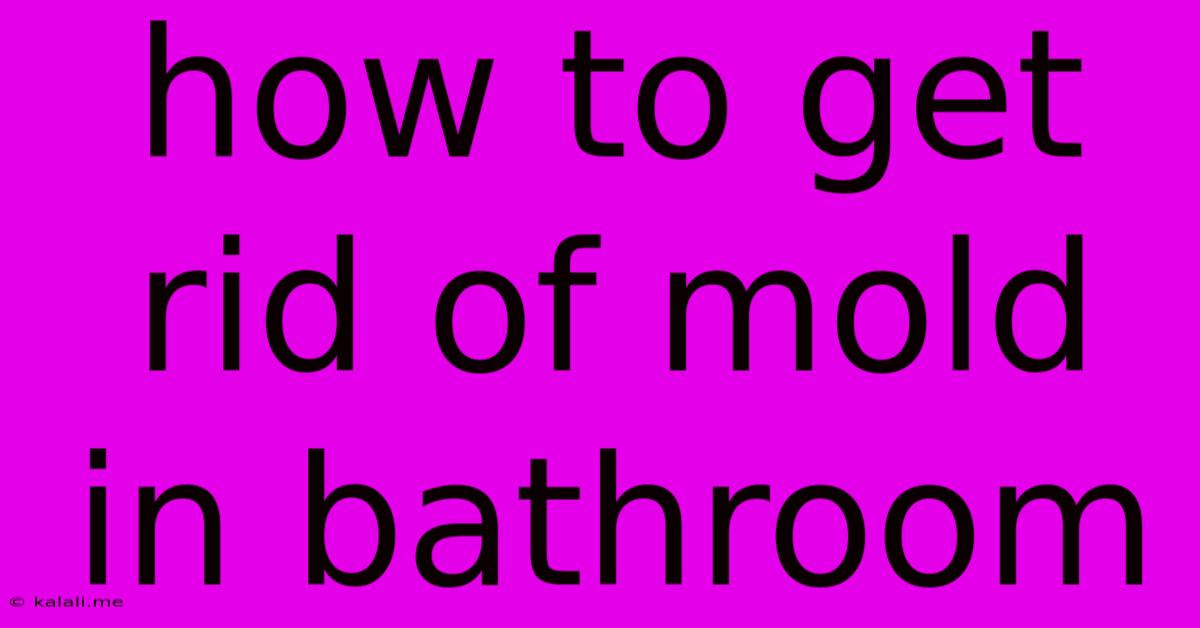How To Get Rid Of Mold In Bathroom
Kalali
May 24, 2025 · 3 min read

Table of Contents
How to Get Rid of Mold in Your Bathroom: A Comprehensive Guide
Mold in the bathroom? It's a common problem, often stemming from excess moisture and poor ventilation. But don't panic! This comprehensive guide provides step-by-step instructions on how to effectively remove mold and prevent its return, ensuring a clean, healthy, and fresh-smelling bathroom. This guide covers everything from identifying mold to employing preventative measures.
Identifying Mold and Assessing the Damage
Before you start cleaning, accurately identifying the extent of the mold infestation is crucial. Mold can present in various colors, including black, green, gray, or white, often appearing as fuzzy patches or slimy spots. Small areas are usually manageable with DIY methods, while extensive mold growth might require professional help. If you have a large mold problem, or if you're experiencing health issues related to mold exposure (such as allergies or respiratory problems), it's best to call a professional mold remediation specialist.
Gather Your Supplies:
Before tackling the mold, gather these essential supplies:
- Personal Protective Equipment (PPE): This is non-negotiable! Wear rubber gloves, safety glasses, and an N95 respirator mask to protect yourself from mold spores.
- Cleaning Solution: A solution of bleach and water (1 part bleach to 10 parts water) is effective for many mold types. Alternatively, you can use a commercial mold cleaner. Always test any cleaning solution in an inconspicuous area first to ensure it doesn't damage the surface.
- Scrub Brush: A stiff-bristled brush is ideal for scrubbing away mold.
- Spray Bottle: For easy application of the cleaning solution.
- Sponge or cloths: For wiping away the cleaning solution and mold.
- Ventilation: Ensure proper ventilation, either by opening windows or using an exhaust fan.
- Dehumidifier: Consider using a dehumidifier, especially in bathrooms with persistent moisture issues.
Step-by-Step Mold Removal:
- Preparation: Protect the surrounding area with plastic sheeting or drop cloths. This prevents the spread of mold spores.
- Ventilation: Maximize ventilation to prevent the spread of spores during cleaning.
- Cleaning: Spray the affected area generously with your chosen cleaning solution. Let it sit for approximately 10-15 minutes to allow the solution to penetrate the mold.
- Scrubbing: Using your scrub brush, gently scrub the affected area, removing the mold. Be careful not to damage the underlying surface.
- Rinsing: Thoroughly rinse the area with clean water, removing all traces of the cleaning solution.
- Drying: Completely dry the area using a clean cloth or allow it to air dry. A fan can help accelerate the drying process. Thorough drying is critical to prevent mold regrowth.
Preventing Mold Growth:
Preventing mold is far easier than removing it. Here are some key preventative measures:
- Ventilation: Ensure adequate ventilation in your bathroom. Use the exhaust fan during and after showers.
- Moisture Control: Immediately wipe up any spills or leaks. Fix leaky faucets and pipes promptly.
- Regular Cleaning: Regularly clean your bathroom, paying special attention to areas prone to moisture build-up, such as grout and shower sealant.
- Dehumidifier: Consider using a dehumidifier, especially if your bathroom is prone to high humidity.
- Caulk and Sealant: Regularly inspect and replace caulk and sealant around tubs, showers, and sinks to prevent water penetration.
Addressing Persistent Mold Issues:
If mold continues to reappear despite your efforts, you may have a more serious underlying problem, such as a persistent leak or inadequate ventilation. In these cases, professional help may be necessary. A professional mold remediation service will identify the source of the moisture problem and implement a proper remediation strategy. This is especially important for larger mold infestations or if you suspect mold damage behind walls or under flooring.
By following these steps and implementing preventative measures, you can effectively eliminate mold from your bathroom and create a healthier, cleaner, and more comfortable environment. Remember, prevention is key!
Latest Posts
Latest Posts
-
Lftp Sync Remote To Local In Linux
May 24, 2025
-
How To Unfreeze Frozen Water Pipes
May 24, 2025
-
Water Comes Out Of Shower Head And Faucet
May 24, 2025
-
Can A House Settle After 20 Years
May 24, 2025
-
Breaking Bad Why Were They Crawling
May 24, 2025
Related Post
Thank you for visiting our website which covers about How To Get Rid Of Mold In Bathroom . We hope the information provided has been useful to you. Feel free to contact us if you have any questions or need further assistance. See you next time and don't miss to bookmark.